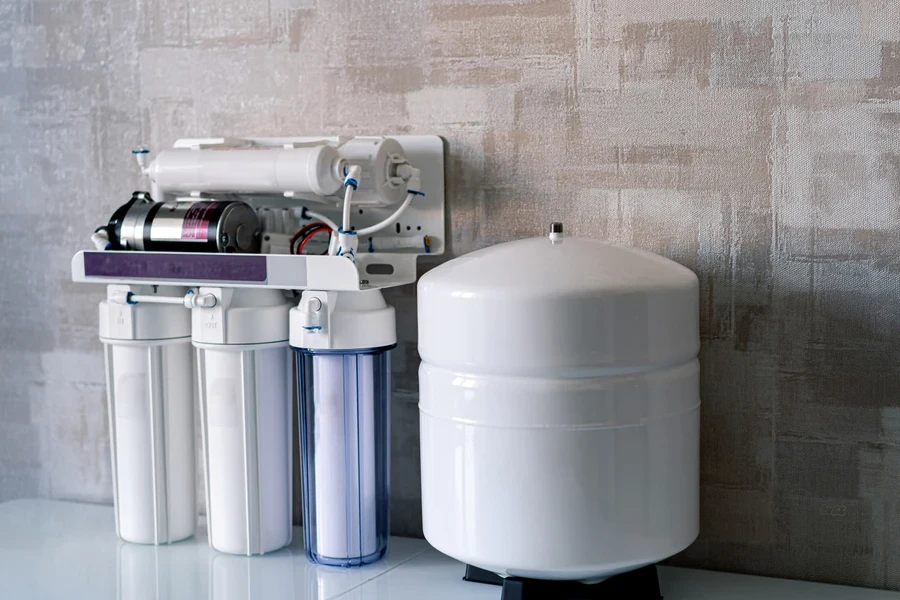Water purifiers are crucial for delivering safe and clean drinking water, essential for any business environment. In 2025, the variety of options available can make the selection process complex. The right water purifier not only ensures the health and well-being of employees but also enhances productivity by providing access to contaminant-free water. This guide is designed to assist online retailers in identifying the best water purifiers, leveraging the latest technologies and trends to meet diverse needs efficiently.
Table of Contents
1. Understanding the Global Water Purifier Market
2. Key Considerations for Selecting Water Purifiers
3. Top Water Purifiers and Their Features in 2025
4. Conclusion

Understanding the Global Water Purifier Market
The global water purifier market is poised for significant growth, driven by heightened awareness of waterborne diseases and the increasing need for safe drinking water. In 2023, the market was valued at approximately USD 45.3 billion and is expected to grow at a compound annual growth rate (CAGR) of around 8.4% from 2024 to 2034. This growth is propelled by the rising environmental consciousness and a shift towards sustainable products, such as water purifiers that reduce the reliance on single-use plastic bottles.
Key regions contributing to this market expansion include North America, Europe, and the Asia-Pacific. North America, with its stringent water quality regulations and high consumer awareness, held a significant market share in 2023. However, the Asia-Pacific region is projected to experience the fastest growth, driven by rapid urbanization, industrial activities, and increasing pollution levels, particularly in countries like China and India.
Key Considerations for Selecting Water Purifiers

Water Quality and Contaminants
Understanding the specific water quality issues in your area is paramount when choosing a water purifier. Different regions have different contaminants, such as heavy metals, bacteria, viruses, and chemical pollutants. For instance, urban areas might struggle with industrial pollutants, while rural areas might have issues with bacterial contamination. Therefore, selecting a purifier that addresses these specific contaminants is crucial. According to NSF, not all water purifiers remove all types of contaminants, so it’s vital to choose one that targets the specific impurities present in your water supply.
Types of Water Purifiers
Different types of water purifiers are designed to tackle various contaminants:
- Activated Carbon Filters: These are effective in removing chlorine, organic compounds, and some heavy metals. They work through adsorption, where contaminants are trapped in the pores of the carbon filter.
- Reverse Osmosis (RO): RO systems are highly effective, removing a broad spectrum of contaminants including bacteria, viruses, dissolved solids, and heavy metals. They operate by pushing water through a semi-permeable membrane.
- Ultraviolet (UV) Purifiers: UV purifiers are excellent for eliminating bacteria and viruses. They use UV light to kill microorganisms without adding chemicals to the water.
- Gravity-Based Purifiers: These are suitable for areas with intermittent electricity supply as they do not require power. They use gravity to filter water through a medium, removing larger particles and some microorganisms.
Selecting the right type of purifier depends on the specific contaminants in your water and your purification needs. For example, Water Filter Stuff emphasizes that mechanical filtration is ideal for sediment and turbidity, while chemical and biological contaminants are better handled by RO or UV systems.

Capacity and Usage
Matching the purifier’s capacity with your demand is essential. Purifiers come in various capacities, and choosing one that meets your daily water consumption needs is crucial for uninterrupted supply. For instance, a purifier with a capacity of under 30 liters per day might cause anxiety over insufficient supply in high-demand environments, while those over 200 liters provide confidence in meeting large demands. This consideration is particularly important for businesses where a steady supply of purified water is necessary to maintain operations and employee satisfaction.
Maintenance and Operating Costs
Maintenance requirements and operating costs are significant factors to consider. Regular filter replacements and maintenance are necessary to ensure optimal performance and water quality. Modern purifiers often come with indicators that alert you when it’s time to replace filters, which is crucial for maintaining efficiency. It’s important to consider the frequency of filter replacements and the availability of parts. Higher initial costs might be justified by lower long-term maintenance expenses.
Certification and Standards
Certifications from reputable organizations like NSF International and the Water Quality Association ensure that the purifier meets specific performance and safety standards. These certifications provide assurance that the purifier has undergone rigorous testing and is effective in removing contaminants. Ensuring compliance with local and international standards is crucial for reliability and consumer trust. For instance, NSF/ANSI 53 certification indicates the purifier’s capability to reduce specific health-related contaminants, such as lead and VOCs.
Top Water Purifiers and Their Features in 2025

Premium Models
The iSpring RCC7 is a standout among smart RO purifiers, featuring a five-stage reverse osmosis process that effectively removes 100% of chlorine, fluoride, copper, and lead. Additionally, it eliminates 99.9% of sulfate and iron, making it ideal for high-contaminant areas. This model also includes real-time water quality monitoring and Wi-Fi connectivity for convenient control and maintenance reminders, ensuring optimal performance at all times.
The LARQ Bottle PureVis uses UV-C LED technology to eliminate 99.99% of bacteria, viruses, and other harmful pathogens. This self-cleaning bottle not only purifies water but also keeps the bottle itself fresh and odor-free. Its sleek design and portability make it perfect for business professionals on the go, providing a reliable source of clean water without the need for frequent manual cleaning.
Eco-Friendly Options
The ZeroWater 10-Cup Pitcher stands out as an eco-friendly option due to its advanced five-stage filtration system that removes 100% of lead, chlorine, fluoride, and other contaminants. This pitcher is also certified to remove PFOAs, offering a sustainable alternative to bottled water and reducing environmental impact significantly. Its gravity-fed system does not require electricity, making it ideal for off-grid locations.
The AquaTru Countertop RO System is designed to minimize water wastage through its efficient four-stage filtration process. It effectively removes 83 contaminants, including lead, arsenic, and nitrates, while retaining essential minerals. This system’s user-friendly design includes a digital display for filter status and a compact footprint that fits well in any office kitchen or break room.

Budget-Friendly Choices
The Brita Large Stream Filter is an excellent budget-friendly option, featuring an activated carbon filter that reduces chlorine taste and odor while retaining beneficial minerals. It has a 10-cup capacity and an electronic filter indicator for timely replacements, making it a practical choice for small offices and homes.
The PUR PLUS Faucet Mount Water Filtration System offers a cost-effective solution for those looking for easy installation and maintenance. This system filters up to 100 gallons of water per cartridge, removing over 70 contaminants including lead and pesticides. Its small form factor and tool-free installation make it a versatile option for various kitchen setups.
Conclusion
Choosing the right water purifier in 2025 involves understanding market trends, local water quality issues, and specific user needs. By considering key factors such as contaminant removal efficiency, capacity, maintenance requirements, and certifications, online retailers can make informed decisions to meet customer demands effectively. Exploring top products from premium models to budget-friendly options ensures that businesses can provide safe, clean drinking water, enhancing employee well-being and productivity.




